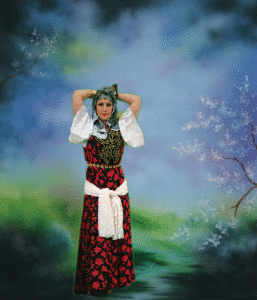
 Zindali
Zindali
(Algerian folklore from Constantine)
(North Border of Tunisia and Algeria)
Zindali has a rhythm and dance style typically found in Northeast Algerian (Constantine, Annaba, Batna, Souk Ahras and (Northwest Tunisia).
This dance improvisation is performed by women and the important value of movement concentrated with movement of the stomach. (Like the dance of Oranaise “Oran”) The symbolization in this dance is the dropping of the egg before menstruation (period).
This hip/stomach movement is also found in the dance style in Oran, West side of Algeria, near Morocco. Zindali is found in cities and family fests as opposed to the countryside. The women take turns dancing one after the other or a couple of women tie a scarf on the hips of another woman encouraging her to dance.
The dance is done on both feet, flat or demi point and the knees are soft which allows balance in the body in order for the hips to be able to move forward and back and upward accents.
 The arms are about the same level of the breasts making graceful movements. The arms are extended by the use of small scarves (i.e., andalou). Every woman makes her improvisation. Sometimes a dancer can go into a trance and fall to the floor.
The arms are about the same level of the breasts making graceful movements. The arms are extended by the use of small scarves (i.e., andalou). Every woman makes her improvisation. Sometimes a dancer can go into a trance and fall to the floor.
The Zindali comes from the music of the Malouf and has a very large repertoire. They are accompanied from orchestra populaires with air instruments (a vent) like flutes (hautbois) and many other percussion instruments, i.e., bendir, darbouka, tar, t’bilat (plural of two headed drum or sometimes called Naqqarat) with two small sticks, t’bel (large drum with one small stick and one thick stick like a Turkish drum or what they use in the Ghawazii). Today by the Zindali popular it is possible to use other instruments.
In the Zindali, we can certify in particular the influence of the costume accentuates the gestures of the dance. The body of the woman is covered with one heavy dress of velour with borders of thread in gold or silver. Through arm movements, the people can discover her jewelry and wealth. A belt and cone shaped hat is also used (see photo of Khadejah).
In Souk Ahras in Tunisia the robe is made out of light fabric or veil like muslin which shows more of the movement of the dancer. At family fests, men try to impersonate the women. This dance by the men is called Hedaoui.
| References: Mustapha El Oueslati, [email protected], Khadejah El Oueslati, [email protected], Spektrum Orientalischer Tanz bei Nabila Shams El Din dtd April 2004, Buch # 10.20.068, nabila-shams-el-din.de/Professor Hedi El Cheriffa, Leon, France/Danses du Maghreb d’une rive `a l’autre, Editions Karthala, 1987/Halima B20644F, 4th Quartal 2003 |
